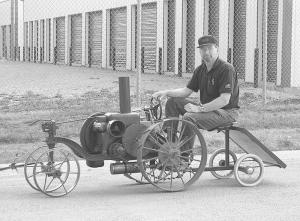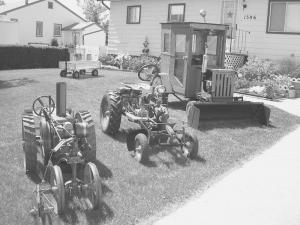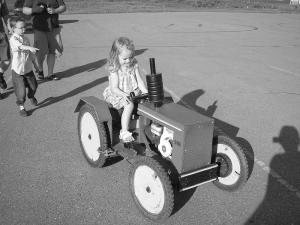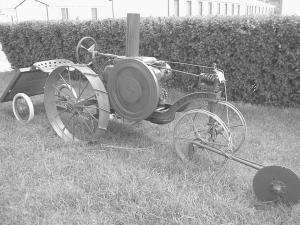Pint-Size Tractors Fit The Need
Gary Anderson's tractors may be small, but they get the job done. From garden tractors to a working tractor for his toddler son to a memorial to his grandfather, Anderson has built them all. Whether it's a working half-size model of a 1917 Mogul 8-16 or a G-style Allis Chalmers, most parts were salvaged or give-aways.
"I built my first tractor in 1972 for mowing, cultivating and snow plowing, and it still works," says Anderson. "The body was cut from plywood, and it had transmissions from two old Chevys, a rear axle from another small car, and a steering gearbox from an old truck."
The frame was made with angle iron, and the front axle was fashioned from pipe. An 11-hp Briggs and Stratton gave it all the power Anderson needed for his 5-ft. wide implements. He made the cultivator and the snow blade and adapted the mower to the tractor. The snow blade raised and lowered hydraulically with the pump driven directly off the engine. He used a peanut butter jar for an oil reservoir.
Anderson ran a belt from the engine to the drive. The homemade garden tractor featured not one, but two transmissions, one a 3-speed from a 1938 Chevy and the other from a 1939 Chevy straight stick on the column.
"It could creep along or travel down the road at 20 mph," says Anderson. "Until recently I used it for snowplowing. After the first winter, I built a cab out of plywood. I could work in the coldest weather without gloves. The cab even had a beacon on the top, lights and a horn that ran off the battery."
Anderson's next tractor was made for his two-year old son in 1985. At the time he had no access to a welder, so nearly the entire tractor was made from wood, including the wheels.
A 2-hp Briggs and Stratton gave it just enough power to pull a couple coaster wagons with other kids on it. Anderson pulled a very small rack and pinion system from a car at the local salvage yard and adapted it to other scrap parts to make a steering system. The simple drive consisted of a belt to the axle with pulleys sized so top speed was only walking speed.
"My son quickly learned that he could hold the foot pedal down to keep the clutch engaged. I think he and my daughters learned the basics of driving with that tractor. He drove it until he was at least 8, and now my granddaughter is starting to use it."
Anderson's latest tractor is one he built in the style of a model G Allis-Chalmers. He needed a smaller tractor and blade for clearing snow on sidewalks in his neighborhood. The Chinese-built 6.5-hp motor he bought for $90 was one of the few parts he purchased new.
"I recycled a transmission and differential from an old riding lawn mower," says Anderson. "The steering box came out of an old truck, and the back wheels from an old swather. Most of the other parts came from the scrap box."
The differential had sprockets on each side and he used them to drive sprockets on the rear wheels. Like the old G, the motor was mounted on the rear, and the blade sits behind the front wheels mounted to a small 3-pt. hitch fabricated by Anderson. This coming year, he plans to adapt a Sears lawn mower to mount on the 3-pt.
Luck played a role in Anderson building his most unique tractor. A friend gave him an old International Harvester engine his family had used in the 1940's. After getting it cleaned up and running, Anderson realized it closely resembled the engine of the Mogul 8-16 that his grandfather bought new in 1917.
"It had the valves on the same side and the rocker arms exposed the same way. The transmission was on the left and the magneto on the right," says Anderson. "I also had some old horse drawn implement wheels that were similar to the Mogul's. The pump was 48 percent scale and the wheels were 45 percent, so I did the tractor at about 45 percent scale."
Like the original, Anderson fashioned a friction drive from the engine pulley back to the rear wheel, driving only one wheel rather than fabricating a differential. The steering mechanism was a worm gear and wheel used to turn the blower on a threshing machine. Anderson simply put a longer rod on it. He also put a short false pipe on the water jacket in imitation of the Mogul.
The biggest challenge for him was the curved frame on the original. Anderson cut slices from one leg of a length of angle iron, bent it and welded it solid.
As a final touch, Anderson added a furrow guide. He recalled his grandfather telling him he would get the tractor started and get off, letting the furrow guide attachment steer the tractor down the field. He would walk along side the slow tractor, tossing stones into a stone boat attached behind the plow.
Instead of pulling a plow, Anderson attached a small cart he can sit in while driving the tractor. Like the original, it only travels about 2 1/2 mph.
"The steel wheels clatter along on pavement like an old tractor would," says Anderson. "I've entered it in a few slow-races, where the operator has to crank start a tractor and drive to the finish line. I just spin the flywheel and go."
Contact: FARM SHOW Followup, Gary Anderson, Box 1472, Didsbury, Alta., Canada T0M0W0 (ph 403 335-9425).

Click here to download page story appeared in.
Click here to read entire issue
Pint-Size Tractors Fit The Need AG WORLD Ag World Gary Anderson s tractors may be small but they get the job done From garden tractors to a working tractor for his toddler son to a memorial to his grandfather Anderson has built them all Whether it s a working half-size model of a 1917 Mogul 8-16 or a G-style Allis Chalmers most parts were salvaged or give-aways
I built my first tractor in 1972 for mowing cultivating and snow plowing and it still works says Anderson The body was cut from plywood and it had transmissions from two old Chevys a rear axle from another small car and a steering gearbox from an old truck
The frame was made with angle iron and the front axle was fashioned from pipe An 11-hp Briggs and Stratton gave it all the power Anderson needed for his 5-ft wide implements He made the cultivator and the snow blade and adapted the mower to the tractor The snow blade raised and lowered hydraulically with the pump driven directly off the engine He used a peanut butter jar for an oil reservoir
Anderson ran a belt from the engine to the drive The homemade garden tractor featured not one but two transmissions one a 3-speed from a 1938 Chevy and the other from a 1939 Chevy straight stick on the column
It could creep along or travel down the road at 20 mph says Anderson Until recently I used it for snowplowing After the first winter I built a cab out of plywood I could work in the coldest weather without gloves The cab even had a beacon on the top lights and a horn that ran off the battery
Anderson s next tractor was made for his two-year old son in 1985 At the time he had no access to a welder so nearly the entire tractor was made from wood including the wheels
A 2-hp Briggs and Stratton gave it just enough power to pull a couple coaster wagons with other kids on it Anderson pulled a very small rack and pinion system from a car at the local salvage yard and adapted it to other scrap parts to make a steering system The simple drive consisted of a belt to the axle with pulleys sized so top speed was only walking speed
My son quickly learned that he could hold the foot pedal down to keep the clutch engaged I think he and my daughters learned the basics of driving with that tractor He drove it until he was at least 8 and now my granddaughter is starting to use it
Anderson s latest tractor is one he built in the style of a model G Allis-Chalmers He needed a smaller tractor and blade for clearing snow on sidewalks in his neighborhood The Chinese-built 6 5-hp motor he bought for $90 was one of the few parts he purchased new
I recycled a transmission and differential from an old riding lawn mower says Anderson The steering box came out of an old truck and the back wheels from an old swather Most of the other parts came from the scrap box
The differential had sprockets on each side and he used them to drive sprockets on the rear wheels Like the old G the motor was mounted on the rear and the blade sits behind the front wheels mounted to a small 3-pt hitch fabricated by Anderson This coming year he plans to adapt a Sears lawn mower to mount on the 3-pt
Luck played a role in Anderson building his most unique tractor A friend gave him an old International Harvester engine his family had used in the 1940 s After getting it cleaned up and running Anderson realized it closely resembled the engine of the Mogul 8-16 that his grandfather bought new in 1917
It had the valves on the same side and the rocker arms exposed the same way The transmission was on the left and the magneto on the right says Anderson I also had some old horse drawn implement wheels that were similar to the Mogul s The pump was 48 percent scale and the wheels were 45 percent so I did the tractor at about 45 percent scale
Like the original Anderson fashioned a friction drive from the engine pulley back to the rear wheel driving only one wheel rather than fabricating a differential The steering mechanism was a worm gear and wheel used to turn the blower on a threshing machine Anderson simply put a longer rod on it He also put a short false pipe on the water jacket in imitation of the Mogul
The biggest challenge for him was the curved frame on the original Anderson cut slices from one leg of a length of angle iron bent it and welded it solid
As a final touch Anderson added a furrow guide He recalled his grandfather telling him he would get the tractor started and get off letting the furrow guide attachment steer the tractor down the field He would walk along side the slow tractor tossing stones into a stone boat attached behind the plow
Instead of pulling a plow Anderson attached a small cart he can sit in while driving the tractor Like the original it only travels about 2 1/2 mph
The steel wheels clatter along on pavement like an old tractor would says Anderson I ve entered it in a few slow-races where the operator has to crank start a tractor and drive to the finish line I just spin the flywheel and go
Contact: FARM SHOW Followup Gary Anderson Box 1472 Didsbury Alta Canada T0M0W0 ph 403 335-9425
To read the rest of this story, download this issue below or click
here to register with your account number.










